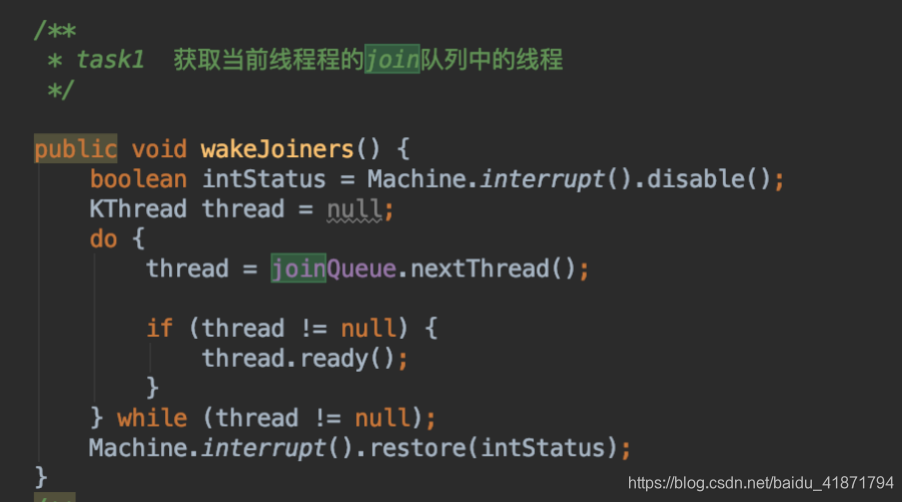操作系统课程设计Project1,实现内核线程操作
https://github.com/ccclll777/nachos_os_design 如果觉得有用,请点个star
刚拿到nachos之后,都不知道从哪里开始下手,只能从目录结构开始,慢慢熟悉整个nachos。1.Nachos.ag包 2.Nachos.machine包 3.配置文件的加载类config 4.有关操作系统中断模拟类interrupt 5.内核的抽象类kernel; 6.全局的工具类lib 7.Machine类 8.Openfile类,StubFileSystem类 9.Stats类 10.Timer类 11.Processor类 12.TCB类 13.network包 14.test包: 15.threads包: 16.Alarm类: 17.KThread类: 系统的运行:
【1】总体描述 【2】task1:实现kthread.join() 【2.1】要求分析 【2.2】实现方式
需要在线程finish时,将自身join队列上的线程释放,加入等待队列等待调度。
【2.3】测试以及结果
说明:在主线程上调用了t1.join,在t1线程上调用了t2.join,所以有如下的运行结果。
【3】task2:使用开关中断提供原子性,实现条件变量 【3.1】要求分析 【3.2】实现方式
wake()唤醒条件变量队列中第一个线程,在试验中利用从线程队列中取出线程用 KThread. ready()实现唤醒,加入就绪队列。(同样要在wake函数利用 中断保证原子性)
【3.3】测试以及结果
【4】task3:实现alarm类的waituntil(long x)方法 【4.1】要求分析 【4.2】实现方案
waitUntil()方法使用了一个队列可以存放线程以及唤醒时间,这个队列以时间为序的有序队列。每次调用时,把当前线程和唤醒时间加入队列,等 待唤醒。在调用 waitUnt il(x)函数时,首先得到关于该线程的信息(线程:当
在时钟回调函数中(大约每500个时钟间隔调用一次)有一次中断,中断时则依次检查队列中的每个对象,将队列中此时应 当唤醒的进程加入就绪队列。如果唤醒时间大于当前时间,则将该对象移出队列并执行wake操作将相应线程唤醒。
【4.3】测试代码及测试结果
说明:启动了20个线程分别wait随机的一段时间,然后会发现线程唤醒的时间一定在它能被唤醒的要求时间之后。【5】task4:用条件变量实现消息的收取speak和发送listen 【5.1】要求分析
【5.2】实现方式
对于listener:要先获得锁,然后尝试唤醒speaker,如果没有speaker等待,则把listener放入队列然后睡眠。如果有speaker等待,就要唤醒一个speaker,将自己挂起等待speaker准备好数据将自己唤醒,然后传递消息,最后释放锁。
【5.3】测试代码及结果
说明:每个listener收到消息后,下一个speaker才会发出消息,两者一一对应。
public class PriorityScheduler extends Scheduler public PriorityScheduler () } public ThreadQueue newThreadQueue (boolean transferPriority) return new PriorityQueue(transferPriority); } public int getPriority (KThread thread) Lib.assertTrue(Machine.interrupt().disabled()); return getThreadState(thread).getPriority(); } public int getEffectivePriority (KThread thread) Lib.assertTrue(Machine.interrupt().disabled()); return getThreadState(thread).getEffectivePriority(); } public void setPriority (KThread thread, int priority) Lib.assertTrue(Machine.interrupt().disabled()); Lib.assertTrue(priority >= priorityMinimum && priority <= priorityMaximum); getThreadState(thread).setPriority(priority); } public boolean increasePriority () boolean intStatus = Machine.interrupt().disable(); KThread thread = KThread.currentThread(); int priority = getPriority(thread); if (priority == priorityMaximum) return false ; setPriority(thread, priority + 1 ); Machine.interrupt().restore(intStatus); return true ; } public boolean decreasePriority () boolean intStatus = Machine.interrupt().disable(); KThread thread = KThread.currentThread(); int priority = getPriority(thread); if (priority == priorityMinimum) return false ; setPriority(thread, priority - 1 ); Machine.interrupt().restore(intStatus); return true ; } public static final int priorityDefault = 1 ; public static final int priorityMinimum = 0 ; public static final int priorityMaximum = 7 ; protected ThreadState getThreadState (KThread thread) if (thread.schedulingState == null ) thread.schedulingState = new ThreadState(thread); return (ThreadState) thread.schedulingState; } protected class PriorityQueue extends ThreadQueue PriorityQueue(boolean transferPriority) { cnt = 0 ; this .transferPriority = transferPriority; wait = new TreeSet[priorityMaximum + 1 ]; for (int i = 0 ; i <= priorityMaximum; i++) wait[i] = new TreeSet<ThreadState>(); } public void waitForAccess (KThread thread) Lib.assertTrue(Machine.interrupt().disabled()); getThreadState(thread).waitForAccess(this ); } public void acquire (KThread thread) Lib.assertTrue(Machine.interrupt().disabled()); getThreadState(thread).acquire(this ); if (transferPriority) lockholder = getThreadState(thread); } public KThread nextThread () Lib.assertTrue(Machine.interrupt().disabled()); ThreadState res = pickNextThread(); return res == null ? null : res.thread; } protected ThreadState pickNextThread () ThreadState res = NextThread(); if (lockholder != null ) { lockholder.holdQueues.remove(this ); lockholder.getEffectivePriority(); lockholder = res; } if (res != null ) res.waitQueue = null ; return res; } protected ThreadState NextThread () ThreadState res = null ; for (int i = priorityMaximum; i >= priorityMinimum; i--) if ((res = wait[i].pollFirst()) != null ) break ; return res; } public void print () Lib.assertTrue(Machine.interrupt().disabled()); } public void add (ThreadState thread) wait[thread.effectivePriority].add(thread); } public boolean isEmpty () for (int i = 0 ; i <= priorityMaximum; i++) if (!wait[i].isEmpty()) return false ; return true ; } protected long cnt = 0 ; public boolean transferPriority; protected TreeSet<ThreadState>[] wait; protected ThreadState lockholder = null ; } protected class ThreadState implements Comparable <ThreadState > public ThreadState (KThread thread) this .thread = thread; holdQueues = new LinkedList<PriorityQueue>(); setPriority(priorityDefault); getEffectivePriority(); } public int getPriority () return priority; } public int getEffectivePriority () int res = priority; if (!holdQueues.isEmpty()) { Iterator it = holdQueues.iterator(); while (it.hasNext()) { PriorityQueue holdQueue = (PriorityQueue) it.next(); for (int i = priorityMaximum; i > res; i--) if (!holdQueue.wait[i].isEmpty()) { res = i; break ; } } } if (waitQueue != null && res != effectivePriority) { ((PriorityQueue) waitQueue).wait[effectivePriority].remove(this ); ((PriorityQueue) waitQueue).wait[res].add(this ); } effectivePriority = res; if (lockholder != null ) lockholder.getEffectivePriority(); return res; } public void setPriority (int priority) if (this .priority == priority) return ; this .priority = priority; this .getEffectivePriority(); } public void waitForAccess (PriorityQueue waitQueue) Lib.assertTrue(Machine.interrupt().disabled()); time = ++waitQueue.cnt; this .waitQueue = waitQueue; waitQueue.add(this ); lockholder = waitQueue.lockholder; getEffectivePriority(); } public void acquire (PriorityQueue waitQueue) Lib.assertTrue(Machine.interrupt().disabled()); if (waitQueue.transferPriority) holdQueues.add(waitQueue); Lib.assertTrue(waitQueue.isEmpty()); } protected KThread thread; protected int priority; protected int effectivePriority; protected Long time; ; protected ThreadQueue waitQueue = null ; protected LinkedList holdQueues; protected ThreadState lockholder = null ; public int compareTo (ThreadState target) if (time == target.time) return 0 ; return time > target.time ? 1 : -1 ; } } }
【6.3】测试代码及结果
说明:一共15个线程,1-5不需要锁,6-10需要a锁,11-15需要b锁,每个进程都有着不同的优先级,可以看出有明显的优先级捐赠的痕迹
如果船在O岛,则尽可能让两个孩子都上船,让两个孩子一起到M岛,并且在到达M岛后睡眠;如果此时O岛上没有其他孩子则放弃此次对船的占有,尝试唤醒O岛上的大人。
对于大人:只需在O岛sleep 等待唤醒 如果能上船则上船不能上船则sleep。到达M岛后 唤醒一个孩子 让孩子划船岛O岛。
static void ChildItinerary () bg.initializeChild(); int position = Oahu; while (true ) { conditionLock.acquire(); if (position == Oahu) { while ((boatPosition != Oahu) || (peopleOnBoat > 1 )) { OahuChildCondition.sleep(); } if (peopleOnBoat == 0 ) { peopleOnBoat += 1 ; OahuChildCondition.wakeAll(); numOfChildrenOnOahu -= 1 ; OahuChildCondition.wakeAll(); boatCondition.sleep(); position = Molokai; numOfChildrenOnMolokai += 1 ; MolokaiChildCondition.sleep(); } else { boatCondition.wake(); numOfChildrenOnOahu -= 1 ; bg.ChildRowToMolokai(); bg.ChildRideToMolokai(); OahuChildCondition.wakeAll(); boatPosition = Molokai; peopleOnBoat = 0 ; position = Molokai; numOfChildrenOnMolokai++; if (numOfChildrenOnOahu == 0 && numOfAdultsOnOahu == 0 ) { s1.V(); MolokaiChildCondition.sleep(); } else { numOfChildrenOnMolokai--; bg.ChildRowToOahu(); position = Oahu; boatPosition = Oahu; numOfChildrenOnOahu += 1 ; OahuAdultCondition.wake(); OahuChildCondition.sleep(); } } } else { numOfChildrenOnOahu += 1 ; numOfChildrenOnMolokai -= 1 ; position = Oahu; bg.ChildRowToOahu(); boatPosition = Oahu; OahuChildCondition.wakeAll(); } conditionLock.release(); } }
【7.3】测试代码及实验结果
说明:可以看到一直是先运送小孩,在运送大人的,直到所有人都到达O岛。


























